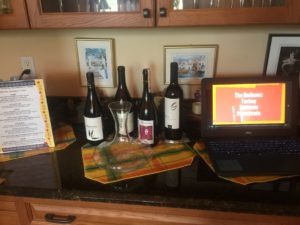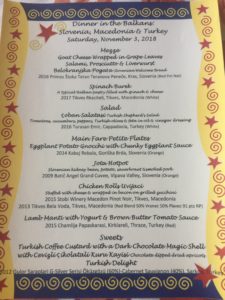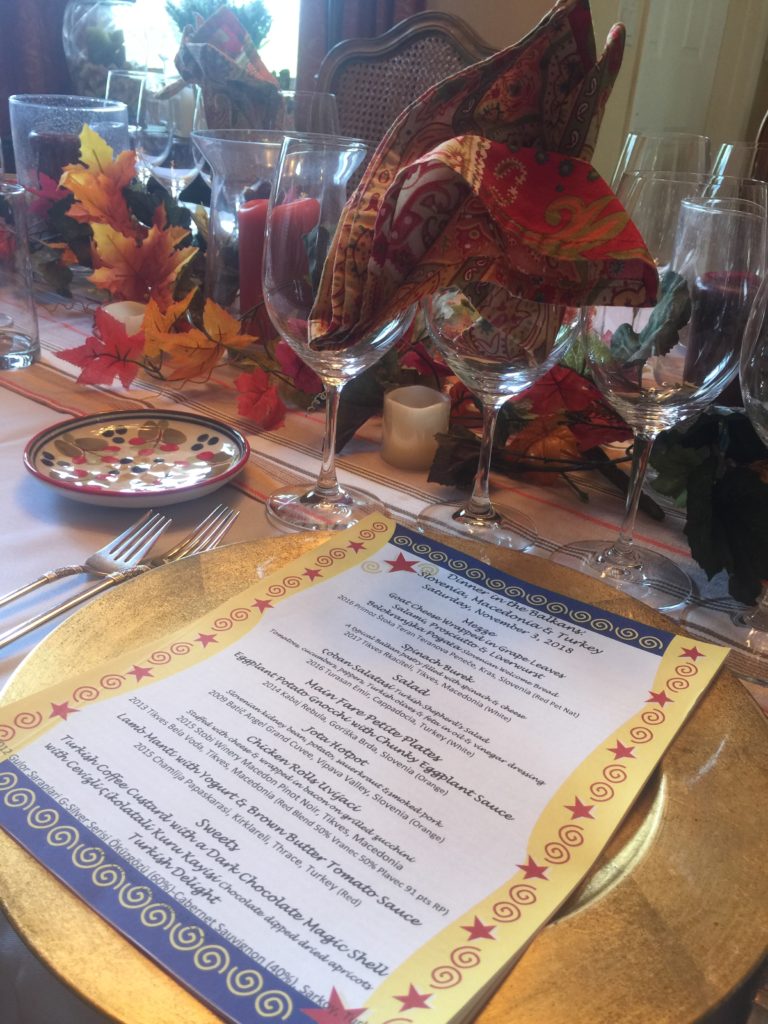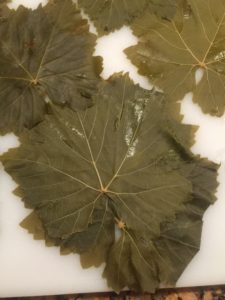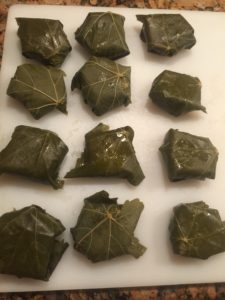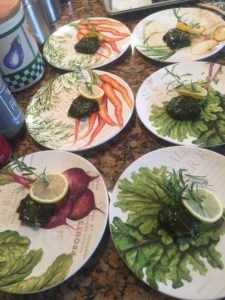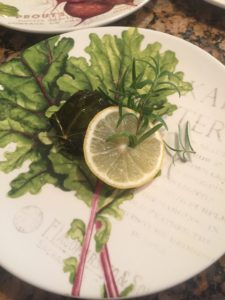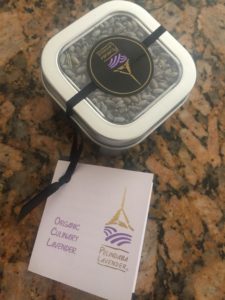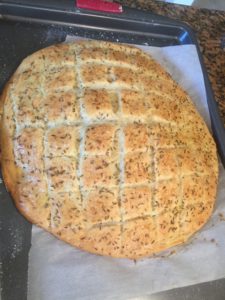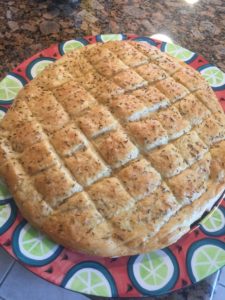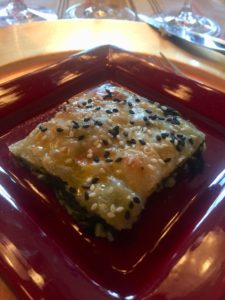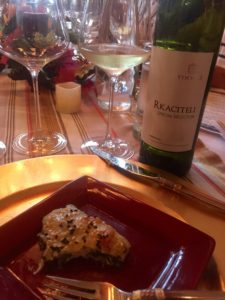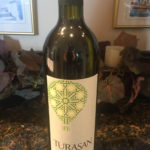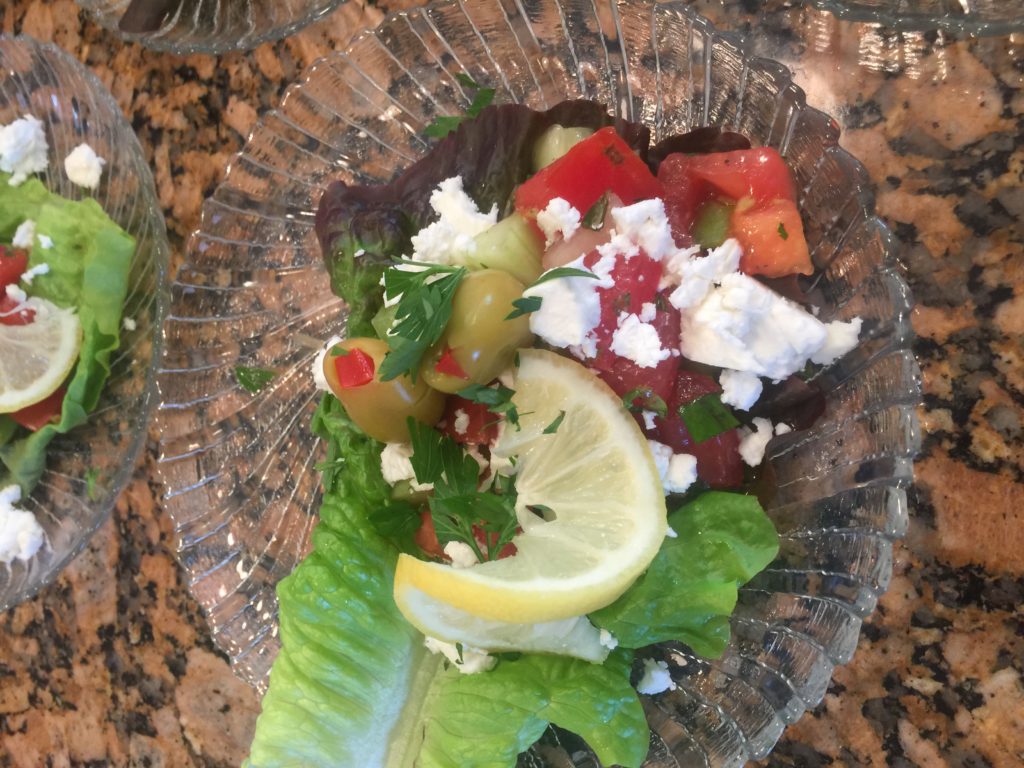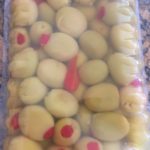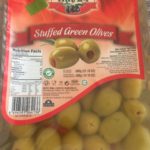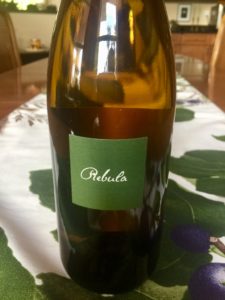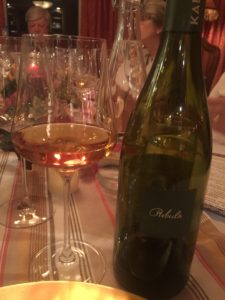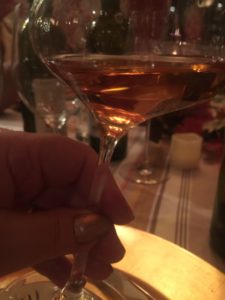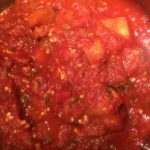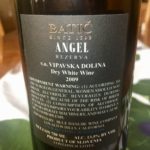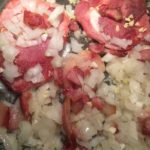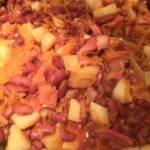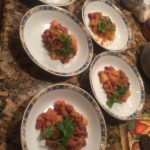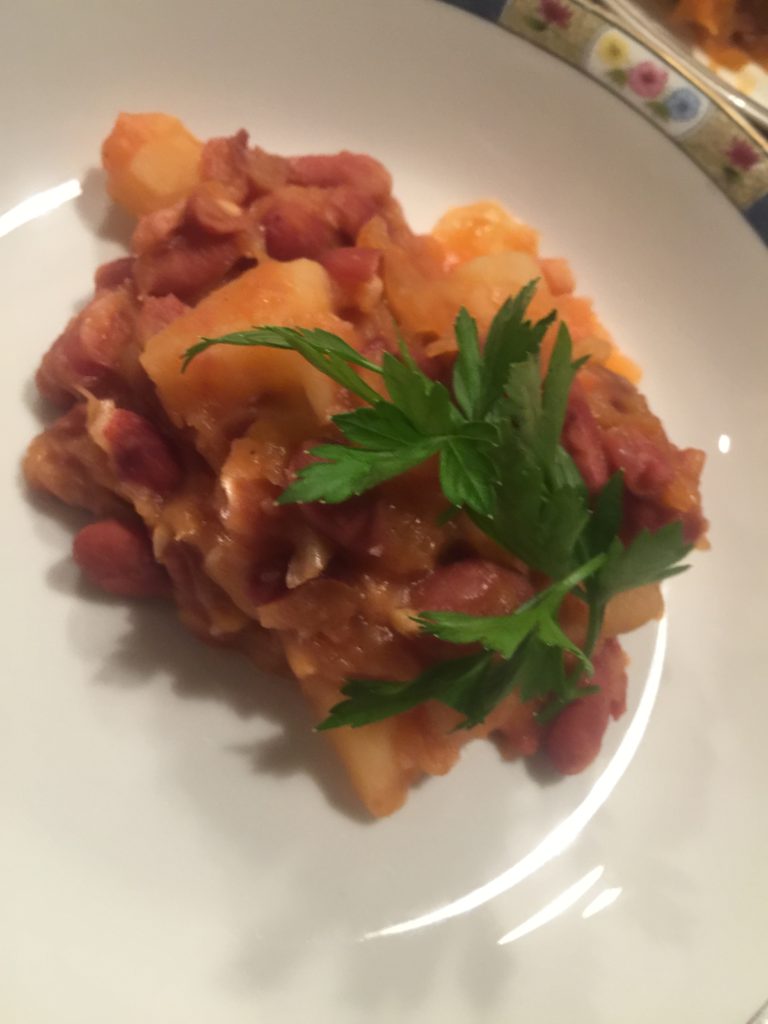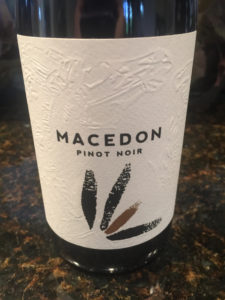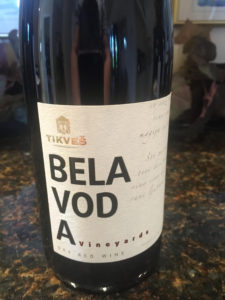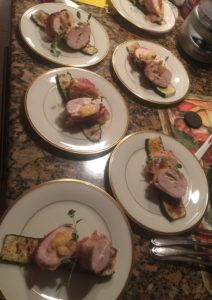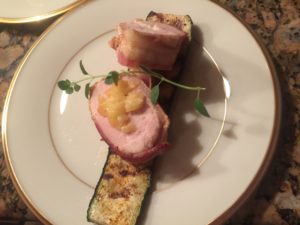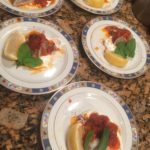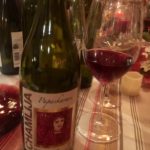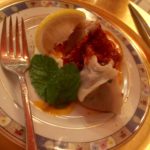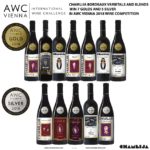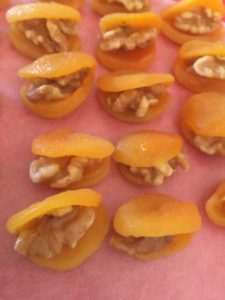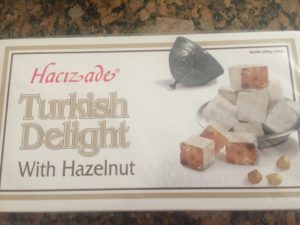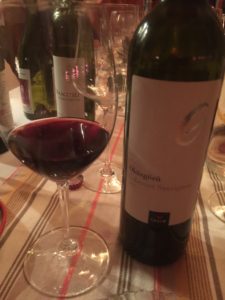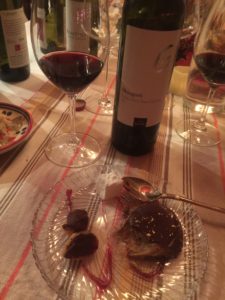Just when I think I have planned and served my most unique wine dinner ever, the next one wins the prize for first place! Seeking out and tasting wine from exotic places has taken center stage for me for the past several years. What do I personally consider “exotic”? “Exotic” and unique covers just about any country or wine region that I am unfamiliar with or whose wines I have never had the opportunity to taste ……….and believe it or not, there are many of those places with many more opportunities yet to come. My husband and I have wined and dined together with a few foodie winelover friends in the wine regions of Lebanon, Hungary, Croatia, Austria, Alsace, Pfalz, Southwest France, Southern Rhone, Santorini, Canary Islands, Sardinia, Sicily and other Italian regions just to name a few, plus many others and all without leaving SW Florida. Therefore our latest unique wine dinner should come as no surprise. It’s a “triple header” – we are dining in the Balkan countries of Slovenia, Macedonia and Turkey – “fork and cork divine” style!
“Dinner in the Balkans” was THE most challenging but most educational and unique wine dinner that I have planned and served to date. On a Saturday night in early November, 2018, six foodie winelover friends gathered at our home in South Fort Myers to embark upon an eight course dinner paired with nine wines from Slovenia, Macedonia and Turkey. I’m sure it was with some trepidation for our friends since they had an opportunity to study the menu and wines in advance, and the wines were like none we have ever poured before. While Teran, Rkaciteli, Emir, Rebula, Vranec, Papaskarasi and Öküzgözü may be everyday drinking wines to some of my international social media winelover friends, I can assure you they have not found their way into SW Florida wine stores or onto our restaurant wine lists! And the food – I’m sure that jota and manti weren’t high on anyone’s bucket list for foods we can’t live without!
You may be wondering “Why oh why did I select these 3 countries for a wine dinner”? I really did have a good reason. There were several bottles of Slovenian wine and one from Turkey in our wine collection that I had purchased when internet browsing for wines from Croatia and Hungary on the Blue Danube Wine Company website, and they were just begging to be tasted! Thanks to one of our friendly wine representatives, a bottle of Macedonian wine appeared. Her comment was that she knew “we would appreciate it”! Guess we are known as the geeky wine people who drink and appreciate unique wines, and truer words could not be spoken. Wanting to make a well-rounded menu with good wine representation from these three countries, I went internet shopping once again and at long last, found some excellent examples on another online wine store website. I’m not even naming them as I can no longer find them on the internet! Finding many of the more unique wines is a major challenge, so if you are not up for this first step, don’t even bother to attempt food and wine pairing, recipes, preparation and service. Or you can take the really easy way out and have me plan the dinner for you.
The Menu
After several months of reading, internet research and writing three separate forkandcorkdivine.com articles about these three Balkan countries, my menu was complete with wines and food pairings that looked on paper like good choices. Never having previously tasted any of the wines or the food items I was about to prepare, I hoped for the best. Our friends learned a long time ago that I often experiment on them! I apologize that you will most likely find this a lengthy article about “dinner”, but just looking at the pictures and names of the food and wine hardly tells the story of how they all came together. This was the end result of months of research and preparation.
Dinner in the Balkans:
Slovenia, Macedonia & Turkey
Saturday, November 3, 2018
Mezze
Goat Cheese Wrapped in Grape Leaves
Salami, Prosciutto & Liverwurst
Belokranjska Pogača Slovenian Welcome Bread
2016 Primoz Štoka Teran Teranova Peneče,
Kras, Slovenia (Red Pet-Nat)
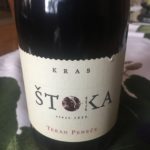 We usually begin our wine dinner events with a sparkling wine, and keeping with tradition we jumped right into the world of uniqueness with a sparkling red Pétillant- Naturel wine from the Kras wine district in Slovenia. Štoka made the first “pet-nat” wine in
We usually begin our wine dinner events with a sparkling wine, and keeping with tradition we jumped right into the world of uniqueness with a sparkling red Pétillant- Naturel wine from the Kras wine district in Slovenia. Štoka made the first “pet-nat” wine in 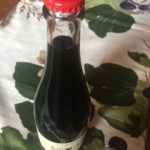 Slovenia, and this one is made from the famous Teran grapes grown in vineyards in the Kras Terra Rosa red soil. It was very dry, tannic and inky with dark berry fruit flavors yet only 12.3% alcohol. And yes, that’s a pop top – not a cork and wire cage. Some of us recalled the Teran wines we enjoyed at our Croatian wine dinner.
Slovenia, and this one is made from the famous Teran grapes grown in vineyards in the Kras Terra Rosa red soil. It was very dry, tannic and inky with dark berry fruit flavors yet only 12.3% alcohol. And yes, that’s a pop top – not a cork and wire cage. Some of us recalled the Teran wines we enjoyed at our Croatian wine dinner.
I paired it up with goat cheese sliced into rounds and edges rolled in a blend of rosemary, thyme and culinary lavender, then wrapped up into a little grape leaf package. Brush the package with EVOO and bake at 450 until cheese is creamy and starts to ooze out of its little package.
My lavender was purchased from the organically certified fields of Pelindaba Lavender on the San Juan Island of Washington State. The grape leaves were organic from Bulgaria right off the shelf at Whole Foods.
Pork and cured meats are served everywhere in Slovenia, and the Karst region is especially famous for their air-cured ham called Pršut. They even have festivals to celebrate it. Unfortunately I could not source any official Pršut cured meats to purchase, so my guests had to settle for Boar’s Head!
I decided to test my baking skills with Belokranjska Pogača, or “Slovenian Welcome Bread”. After a less than perfect test run, that bread coming out of the oven just a few hours before the arrival of our guests was really exciting for me. After all I had followed the Slovenian Protected Agricultural Products guidelines for the finishing touches on it :
“Belokranjska Pogača is a type of flat bread and is produced according to a unique recipe. It is round with a diameter of approximately 30 cm. In the center it is 3 to 4 cm thick, thinning to 1-2 cm at the edges. With oblique lines, it is incised into squares with an approximate distance of 4 cm, coated with a whisked egg and topped with cumin seeds and coarse salt crystals. When baked it is broken along the incised angled lines rather than being cut.”
Best of all – the goat cheese stuffed grape leaves, charcuterie and freshly baked welcome bread proved to be a good pairing with that sparkling Teran. Can’t say that the sparkling was my favorite wine ever, but I can say that I am probably one of the few people (maybe even just 6 people!) in this area who has ever tasted it, and I did enjoy it.
Spinach Burek
A typical Balkan pastry filled with spinach & cheese
2017 Tikves Rkaciteli, Tikves, Macedonia (White)
Our second course found us a little further south in the Balkans to the Republic of Northern Macedonia. Wanting to continue with another mezze-type item, the recipe for spinach burek sounded perfect. Burek is a family of baked filled pastries and typical street-food type item found in many of the Balkan, Eastern Mediterranean and Asian countries. My recipe called for sheets of filo dough stuffed with a cooked fresh spinach feta cheese mixture, then baked and topped with black and white sesame seeds.
I opted to pair the burek with a 2017 Rkaciteli from Tikves Winery. The Rkaciteli was fermented 4 months in stainless steel tanks, golden yellow in color with scents of fresh peach, grapefruit, pineapple and mango and high acidity. It was pretty intense and paired well with the feta and spinach of the burek. Rkaciteli is an ancient grape originally from the Republic of Georgia. The burek was delicious and the pairing was quite interesting.
Salad
Ҁoban Salatasi Turkish Shepherd’s Salad
Tomatoes, cucumbers, peppers, Turkish olives & feta in oil & vinegar dressing
2016 Turasan Emir, Cappadocia, Turkey (White)
The next stop on our trip found us in the amazing Turkish area of Cappadocia, the home of troglodytes and fairy chimneys. They have been making wine here for more than 7,000 years. This region is really fascinating to me, and we drank a wonderful 2016 Emir wine from the Turasan Winery. Emir is indigenous to and only grown right here, and I really enjoyed this wine. It had notes of citrus peel, white flowers and pears and is often compared to Albarino or Pinot Grigio. Only 1500 cases of it were made, and I am so happy to have served it with a beautiful salad typical of Turkey — Ҁoban Salatasi, or Turkish Shepherd’s Salad. The salad was so colorful and light with a bit of oil and vinegar dressing and topped off with feta cheese and Turkish green olives.
The Turkish olives can be found at the Petra Mediterranean Store right here in Fort Myers. Petra was a good source for unique ingredients when I was preparing for our Eastern Mediterranean wine dinner. Side note for my non-foodie friends: Did you know that black olives are green olives that have ripened? In fact green olives right off the tree are so bitter you cannot eat them. It takes the curing or brining process to make them those delicious little morsels that we enjoy in our martinis or on our salads.
Main Fare Petite Plates
With six wines remaining for dinner, I decided to pair five of them with entrees representative of all three countries and to save one wine for the difficult and final challenge of a dessert pairing. Just serving up a “petite plate” of anything is quite a challenge for me. After all I come from a background of “Food for 50” recipes and large quantity cooking. My idea of service is a pan holding at least 25 servings! But I tried my best and think I may have succeeded. Just don’t ask my guests for their opinions!!!!
Eggplant Potato Gnocchi with Chunky Eggplant Sauce
2014 Kabaj Rebula, Goriška Brda, Slovenia (Orange)
Slovenia is well known for making orange or amber wines. While Georgia is officially the birthplace of orange wine, Slovene wine makers have been macerating their white wines underground in Georgian “Qvevri” for many generations. Qvevri are large earthenware vessels resembling egg-shaped amphorae. If you would really like to learn more about orange or “amber” wines, this book by Simon J. Woolf, “Amber Revolution:How the World Learned to Love Orange Wine”, was recently released and I found it fascinating and very educational.
I was ecstatic to have an orange wine made by Jean Michel Morel of Kabaj, one of the premier wineries of Slovenia, to serve at our dinner. Kabaj has won numerous awards for their wines and often selected as one of the top 100 wineries by Wine and Spirits Magazine. Our eyes all opened wide as Chuck poured this 2014 Kabaj Rebula. Wow, was it orange! This particular 100% Rebula (known as Ribolla Gialla in Italy) was macerated 30 days in French oak barrels and 4 months in bottles. Then it was aged for 12 more months in oak barrels and 4 more months in the bottle before ready to drink. It had notes of dried flowers, honey, hazelnuts, citrus peel with a mineral flavor and very long intense finish. It was exquisite for me. Wines like this can and should be served with a food of substance, and after a lot of research I opted for making homemade eggplant gnocchi with a very spicy and chunky eggplant tomato sauce. It was garnished with shaved ricotta salata and fresh basil leaves. After all, this area of Slovenia is very close to Northeastern Italy and many of the foods are similar. My eggplant sauce may have been a bit on the too spicy side, (hot pepper flakes will do that!) but the entire dish was perfect with the Rebula. I cannot wait to have some other wines from Kabaj to taste.
Brushing up on my gnocchi-making skills. First time with eggplant!
Jota Hotpot
Slovenian kidney bean, potato, sauerkraut and smoked pork
2009 Batič Angel Grand Cuvee
Vipava Valley, Slovenia (Orange)
Keeping with the Slovenian orange wine theme, we moved on to Batič, another very well-known winery but this time from the Vipava Valley right up against the Italian border. The Batič family has been making wine since 1592, so they do know a few things about it. Today Ivan, Palmira and their son Miha do extended maceration on the white grapes and are quite famous for their orange wines. Our 2009 Angel Grand Cuvee was a blend of 9 different white grape varieties spanning 3 different vintages. The amber colored wine in our glasses was like no other we have had before and was made from Pinela, Rebula, Zelen, Sauvignon, Chardonnay, Pinot Gris, Klarnica, Fruilano and Vitovska. I defy you to find anything like that on a wine shelf anywhere in this part of the world! The wine had aromas of canned peaches, apricots, other fresh stone fruits and had a very long and creamy finish. It was quite special.
The Batič Angel could not have paired better with our Jota “Hotpot”. Jota 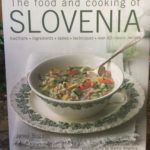 (YOH-tah) is a hearty western region Primorska Slovenian dish that is a cross between a soup and a stew. I chose a traditional version from “The Food and Cooking of Slovenia” cookbook by Janez Bogataj. It was filled with smoked pork and fat-back type bacon seasoned onions, garlic, tomato paste, kidney beans, potatoes and sauerkraut. I prepared it on Friday, then slowly cooked it on low in a crockpot most of Saturday and by the time it went on the plate, the flavors were married together and an excellent choice for our little Angel!
(YOH-tah) is a hearty western region Primorska Slovenian dish that is a cross between a soup and a stew. I chose a traditional version from “The Food and Cooking of Slovenia” cookbook by Janez Bogataj. It was filled with smoked pork and fat-back type bacon seasoned onions, garlic, tomato paste, kidney beans, potatoes and sauerkraut. I prepared it on Friday, then slowly cooked it on low in a crockpot most of Saturday and by the time it went on the plate, the flavors were married together and an excellent choice for our little Angel!
Chicken Rolls Uvijaci
Stuffed with cheese & wrapped in bacon on grilled zucchini
2015 Stobi Winery Macedon Pinot Noir
Tikves, Macedonia
2013 Tikves Bela Voda, Tikves, Macedonia
(Red Blend 50% Vranec 50% Plavec 91 pts RP)
Our next petite entrée represented Macedonia and needed to pair with two Macedonia wines, one an international grape – Pinot Noir – and the other widely grown in Macedonia – Vranec – which was blended with a Plavec. We all enjoy Pinot and found the 2015 Stobi Macedon to be a very drinkable wine full of lush dark fruit. Amazingly enough, a friend of mine had recently read my forkandcorkdivine.com article about Macedonia and recognized this wine on a Naples, Florida restaurant wine list. Being familiar with it from the article, she took a chance on something unique, ordered it and liked it! Stobi is the newest and most modern winery in Macedonia, so I am happy that they are having good results.
The second wine for this pairing was a 2013 Bela Voda from the Tikves Winery in the Tikves wine region. This one came with quite a pedigree. It’s 50% Vranec and 50% Plavec grown on a site-specific location high up in the Kosuf Mountain. And……. Wine Advocate rated it 91 points while the 2011 and 2012 rated between 92 – 94 points. I realize points don’t mean much for a lot of winelovers or wine geeks, but it at least tells me to take an interest in it. This one was outstanding “like a Southern Rhone blend” and I am happy that wines from an unknown and unique wine region such as Macedonia are receiving such accolades and rightfully so.
The chicken rolls “Uvijaci” recipe sounded like a good solid pairing for both the Pinot and Southern Rhone blend-like wine. With the smokiness of Gouda cheese inside a thin chicken breast all wrapped up in bacon, how could we go wrong? Chuck grilled it, finished it off in the oven, and served it on grill-marked ribbons of seasoned zucchini. Getting full anybody? Hang on, only two more courses to go…………………..
Lamb Manti with Yogurt & Brown Butter Tomato Sauce
2015 Chamlija Papaskarasi
Kirklareli, Thrace, Turkey (Red)
I was extremely eager to taste this very indigenous wine from a highly touted winery near the Black Sea in Turkey. Mustafa Camlica founded the Chamlija Winery in 2000; however, his family has been farming here for generations. Chamlija Winery recently won at the 2018 AWC Vienna International Wine Challenge as “Best National Producer of the Year for Turkey”. They also won 7 gold medals and 5 silver medals. And we were about to taste one of those wines, Papaskarasi – a blend of 85% Papaskarasi, 15% Cabernet Franc and 15% Cabernet Sauvignon. The wine was just as Matthew Horkey of Exotic Wine Travel had described it “ light red with notes  of sour cherry, rhubarb, brown spice, white pepper, Mediterranean herbs and violets”. This wine is really a winner! I only wish that I could source more Chamlija wines. Matthew and Charine Tan had recommended Chamlija wines, and I put my money on their recommendations. After all, it was their Exotic Wine Travel book “Uncorking the Caucasus” that got me interested in Turkish wines in the first place. He and Charine Tan had tasted their way through Turkey, Armenia and Georgia a few years ago and wrote about their travels and tasting experiences.
of sour cherry, rhubarb, brown spice, white pepper, Mediterranean herbs and violets”. This wine is really a winner! I only wish that I could source more Chamlija wines. Matthew and Charine Tan had recommended Chamlija wines, and I put my money on their recommendations. After all, it was their Exotic Wine Travel book “Uncorking the Caucasus” that got me interested in Turkish wines in the first place. He and Charine Tan had tasted their way through Turkey, Armenia and Georgia a few years ago and wrote about their travels and tasting experiences.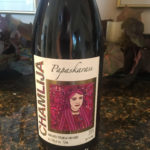
Having read an internet article describing a perfect pairing for this wine to be a typically spicy Turkish dish of lamb manti with yogurt and brown butter tomato sauce, I bought my required Aleppo pepper for the tomato sauce and started practicing on my manti. I’m got ravioli making down fairly well now, so I thought how challenging could this one be? When I started making the little bundles of ground lamb mint lemon cayenne mixture and wrapping them up just so into perfect dumplings, I learned my lesson. However, I will say that the result was a beautiful dish with the prerequisite spice and flavor which actually looked like the picture. The cooked manti dumplings were served on a base of chilled garlic yogurt sauce and topped off with the Aleppo pepper brown butter tomato sauce, then garnished with a sprinkling of sumac, fresh mint leaves and lemon wedge.
Some foodie notes:
Manti: The size of the manti is supposedly in direct proportion to respect for the recipient. Since I had difficulty sealing up my little dumplings, I cannot imagine the degree of difficulty to make one a centimeter square. My manti pastry squares were 7 cm square or app. 2 3/4 inches. The great manti makers from Kayseri in Anatolia are renowned for making the smallest version – so small you can fit a number of them on a spoon!
Aleppo pepper: Aleppo-style pepper is a deep burgundy red mild variety of Capsicum Annuum, is also known as a Halaby pepper, and is about half as hot as the chile pepper flakes or powder that you probably use most often. It gives a medium heat of 10,000 SHU on the Scoville scale. Named after the northern Syrian city of Aleppo, it is now largely sourced from Turkey and elsewhere, due to the challenges of growing and exporting from the war-torn 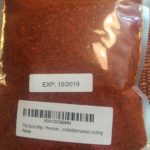 Syrian region. Aleppo is a common Middle Eastern condiment, traditionally used to season meat, beans, salads, and dips, but it can be used like any other dried red pepper. It slowly builds up heat with earthy,
Syrian region. Aleppo is a common Middle Eastern condiment, traditionally used to season meat, beans, salads, and dips, but it can be used like any other dried red pepper. It slowly builds up heat with earthy, 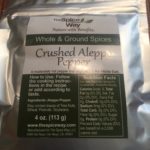 cumin-y undertones and a little bit of fruity tang. Try it as a substitute for crushed red pepper flakes or paprika. My “Aleppo – style” pepper came to me from Spice Way in California by way of Amazon.com, not Turkey or Syria.
cumin-y undertones and a little bit of fruity tang. Try it as a substitute for crushed red pepper flakes or paprika. My “Aleppo – style” pepper came to me from Spice Way in California by way of Amazon.com, not Turkey or Syria.
Sumac: Its an almost purple spice with a tart somewhat vinegary or lemon flavor, and NO – it did not come from the poison sumac tree, a different variety of sumac. Sumac spice has been used for thousands of years in Middle Eastern and Mediterranean cooking. Try sprinkling it on hummus, in salad dressing, or kebabs. My sumac is actually a product of Turkey, and I bought it at Petra Mediterranean Market in Fort Myers.
Sweets
Turkish Coffee Custard
with a Dark Chocolate Magic Shell
Cevizli Ҁikolatali Kuru Kayisi
Chocolate dipped dried apricots
Turkish Delight Candy
2012 Gulor Saraplari G-Silver Serisi Öküzgözü (60%)-Cabernet Sauvignon (40%), Sarkoy, Turkey
My most challenging pairing was the dessert course! I wanted to showcase this 2012 Gulor Öküzgözü-Cabernet blend with something typically Turkish, but as you know pairing a Cabernet with dessert is risky and difficult at best. 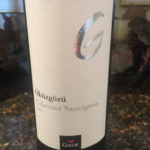 Yes, I wanted to serve some typical Turkish candies, so a plate of Turkish Delight was the easy part. My Turkish Delight was the hazelnut variety and it is yummy. I also found it at the Petra Mediterranean Store in Fort Myers. After lots of internet searching I happened upon this recipe for Turkish Coffee Custard with a Dark Chocolate Magic Shell from Chef Camille Cogswell who was the second pastry chef ever to win the James Beard Award for Rising Star Chef. She is known for melding Israeli ingredients with a Southern flair at the Zahav restaurant in Philadelphia and now the 2018 Rising Star Chef. It’s not a Turkish recipe, but it does have Turkish coffee and chocolate, two things that sounded perfect to me, so I added it to my menu. This recipe took me 3 days to prepare, so planning and advance prep is always key for success. On Day 1, I prepared the custard. At Chef Camille’s recommendation, I decided to
Yes, I wanted to serve some typical Turkish candies, so a plate of Turkish Delight was the easy part. My Turkish Delight was the hazelnut variety and it is yummy. I also found it at the Petra Mediterranean Store in Fort Myers. After lots of internet searching I happened upon this recipe for Turkish Coffee Custard with a Dark Chocolate Magic Shell from Chef Camille Cogswell who was the second pastry chef ever to win the James Beard Award for Rising Star Chef. She is known for melding Israeli ingredients with a Southern flair at the Zahav restaurant in Philadelphia and now the 2018 Rising Star Chef. It’s not a Turkish recipe, but it does have Turkish coffee and chocolate, two things that sounded perfect to me, so I added it to my menu. This recipe took me 3 days to prepare, so planning and advance prep is always key for success. On Day 1, I prepared the custard. At Chef Camille’s recommendation, I decided to  purchase a silicone muffin pan for shaping, baking and freezing my custard cups. It worked perfectly. I was a happy dessert chef when on Day 2 those perfectly round frozen coffee custards popped out of the molds. Next step was turning them into a magic shell. On Day 3, I made my dark chocolate, coconut oil and corn syrup mixture for dipping and it was indeed magic! The chocolate set up
purchase a silicone muffin pan for shaping, baking and freezing my custard cups. It worked perfectly. I was a happy dessert chef when on Day 2 those perfectly round frozen coffee custards popped out of the molds. Next step was turning them into a magic shell. On Day 3, I made my dark chocolate, coconut oil and corn syrup mixture for dipping and it was indeed magic! The chocolate set up  immediately into a hard shell when I dipped the frozen custards into the chocolate. Those three days of prep were really worth it. That Turkish coffee custard looked fabulous on a dessert plate topped with some actual gold dust left from a previous event, and supplemented with Cevizli Ҁikolatali Kuru Kayisi, a typical Turkish fruit dessert of dried apricots that I stuffed with walnut halves and painted with more melted dark chocolate.
immediately into a hard shell when I dipped the frozen custards into the chocolate. Those three days of prep were really worth it. That Turkish coffee custard looked fabulous on a dessert plate topped with some actual gold dust left from a previous event, and supplemented with Cevizli Ҁikolatali Kuru Kayisi, a typical Turkish fruit dessert of dried apricots that I stuffed with walnut halves and painted with more melted dark chocolate.
Oh yes, the wine……….the Gulor Öküzgözü-Cabernet blend gave up red and black fruit with spicy black pepper and violet aromas, nicely balanced acidity and tannins and great fruit on a lengthy finish. Gulor was the first boutique winery in Turkey and is located on the north shore of the Marmara Sea. The winemaker is from Languedoc and obviously knows how to make great wine. This blend has won numerous awards including Bronze at the 2015 IWC in San Francisco, and I am sorry that I only purchased one bottle. I think my dessert and wine pairing passed the challenge!
My Balkan wine dinner is now complete.
This eight-course nine-wine dinner may be history, but the memory of it will last with me forever. The months spent researching about Slovenia, Macedonia and Turkey and their wines, the culinary knowledge required about each country and representative foods, deciding upon appropriate food and wine pairings, finding and interpreting recipes, wine and food product sourcing, the production planning, service setup, and actual food preparation and service is a monumental task. The good news is that I am retired from my professional career, and this has now become my new life. And I love it!!!
During the past several years I have learned about so many grape varieties, wines and wine styles that were all new to me. I’ve also written and published articles about them which you can find on this website. I would not want to be without the power of social media and interaction. They are powerful resources for me. I am so lucky to have become acquainted with many people around the world including wine bloggers, wine travelers, winemakers, winery owners, sales associates and authors. When I can sit with friends in my home here in Southwest Florida and share wines from across the world and then communicate with the people who made them, I am overjoyed! I will probably never see those exotic or unique wine regions, nor meet any of those wonderful people, but drinking the wine connects and unites many people around the world. If you are in a wine rut, or only drink certain wines, you just don’t know what you are missing out on. Please be adventurous and search out as many unique wines as possible! I have many more to find. Onward to our next forkandcorkdivine adventure……………………..
11.16.18
LFRakos@gmail.com

